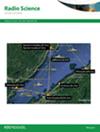D-CDA:利用合成孔径雷达图像进行洪水灾害定位的去噪和变化检测方法
IF 1.6
4区 地球科学
Q3 ASTRONOMY & ASTROPHYSICS
引用次数: 0
摘要
洪水是全世界最具破坏性的自然灾害之一。这种灾害往往伴随着强降水和其他天气因素,使得确定受灾地区变得更加困难。此外,合成孔径雷达(SAR)技术可在 24 小时内捕捉图像,并能穿透云雾。基于合成孔径雷达图像的变化检测(CD)技术通常通过分析灾前和灾后图像之间的差异来定位受灾地区。然而,这种方法面临两个主要挑战:斑点噪声的存在降低了差异检测的准确性,以及缺乏适用于洪水灾害变化检测的合成孔径雷达数据集。因此,本研究提出了一种新颖的两阶段洪水灾害区域定位方法,即去噪变化检测方法(D-CDA)。第一阶段包括一个具有编码器-解码器结构的九层去噪网络,称为合成孔径雷达去噪网络(SDNet)。它利用多残差块和并行卷积块注意模块,在编码过程中提取特征,以抑制噪声成分。在第二阶段,提出了一种新型卷积神经网络来检测位时 SAR 图像之间的变化,即坐标注意融合网络,它以连体网络和 UNet++ 为骨干,融合坐标注意模块来增强变化特征。此外,基于 2021 年中国郑州洪水灾害,利用 Sentinel-1 SAR 图像构建了 CD 数据集(郑州洪水数据集)。仿真验证了所提方法的有效性。实验结果表明,D-CDA 在洪水灾害区域定位方面具有良好的检测性能。本文章由计算机程序翻译,如有差异,请以英文原文为准。
D-CDA: A denoise and change detection approach for flood disaster location from SAR images
Floods are among the most devastating natural disasters worldwide. Such disasters are often accompanied by strong precipitation and other weather factors, making it more difficult to identify affected areas. Moreover, synthetic aperture radar (SAR) technology can capture images in a 24-hr window and penetrate clouds and fog. Change detection (CD) technology based on SAR images is generally utilized to locate disaster-stricken areas by analyzing the differences between pre- and post-disaster images. However, this method faces two main challenges: the presence of speckle noise, which reduces the difference detection accuracy, and the lack of a suitable SAR data set for flood disaster CD. Therefore, this study proposes a novel two-stage approach for locating flood disaster areas, known as the denoising-change detection approach (D-CDA). The first stage comprises a nine-layer denoising network with an encoder-decoder structure known as the SAR denoising network (SDNet). It utilizes a multiresidual block and a parallel convolutional block attention module to extract features during the encoding process to suppress the noise component. In the second stage, a novel convolution neural network is proposed to detect the changes between bitemporal SAR images, namely, the coordinate attention fused network, which combines the siamese network and UNet++ as the backbone, and fuses coordinate attention modules to enhance the change features. Moreover, a CD data set (Zhengzhou flood data set) was constructed using Sentinel-1 SAR images based on the 2021 flood disaster in Zhengzhou, China. Simulations verify the effectiveness of the proposed method. The experimental results indicate that D-CDA achieves favorable detection performance in locating flood disaster areas.
求助全文
通过发布文献求助,成功后即可免费获取论文全文。
去求助
来源期刊

Radio Science
工程技术-地球化学与地球物理
CiteScore
3.30
自引率
12.50%
发文量
112
审稿时长
1 months
期刊介绍:
Radio Science (RDS) publishes original scientific contributions on radio-frequency electromagnetic-propagation and its applications. Contributions covering measurement, modelling, prediction and forecasting techniques pertinent to fields and waves - including antennas, signals and systems, the terrestrial and space environment and radio propagation problems in radio astronomy - are welcome. Contributions may address propagation through, interaction with, and remote sensing of structures, geophysical media, plasmas, and materials, as well as the application of radio frequency electromagnetic techniques to remote sensing of the Earth and other bodies in the solar system.
 求助内容:
求助内容: 应助结果提醒方式:
应助结果提醒方式:


